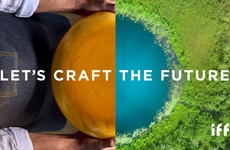An Interview with Cheryl Cran, Founder of Consultation Firm NextMapping
Cheryl Cran is an experienced consultant and a keynote speaker with global recognition who provides companies with tactile solutions of how to adapt to the evolving future. She founded consulting service NextMapping in 1997 and is releasing her latest book — 'NextMapping: Anticipate, Navigate & Create The Future of Work' on February 12th in Canada. In it, she does a deep dive into the dynamics of the contemporary workplace, detailing how technology is shaping the future and how humans can best predict and adapt to those changes.
Trend Hunter spoke with Cheryl about the launch of her new book, the always-on culture, as well as the symbiotic relationship between humans and technology.
How would you describe the always-on culture and how has it shifted the traditional work dynamic?
The always-on culture is a by-product of the technological revolution which started in the early 90s. When e-mail was invented, people thought there was going to be less paperwork, but the service actually created more tasks. In fact, people were working more with e-mail, because they could efficiently transmit messages and documents around the world. From then on, services like social media, instant messaging, the Cloud, BYOD, and more became available to organizations and significantly disrupted the operational dynamic.
Thus, the always-on culture is created through the shift from the traditional nine-to-five workplace where your performance review was based on tasks and reached objectives, to remote work where mobile technology has been established as a viable means of communication. It is the evolution from desktop to laptop to mobile that drives this culture. Today’s emerging workforce is one that does not fit in the traditional structures, because we have the ability to work anywhere, anytime and anyhow.
What do you think the nature of human behavior and emerging technologies is? Does one inform the other?
We are seeing a symbiotic collaboration between humans and robots. A lot of the research at NextMapping is directed at how AI, automation, and robotics infiltrate the workplace. The consequence of this is that humans have to be more flexible, agile, and strive toward collaboration.
In the past, collaboration was more of a siloed effort between departments within an organization. Now, humans are working side by side with technology which helps them work even better with each other and this will extend into the future. AI is already informing communication styles, while AR and VR are helping individuals go through the synthesized motion of a predicament or situation. This allows them to rehearse it prior to the interaction with another human being.
Technology is never going to replace humans because tech is not emotionally aware, lacks empathy and compassion. However, more sensitivity is being built into the future of technology which will affect human beings and allow them to evolve at a faster rate than ever before. This is because evolution comes from a greater accumulation of and access to information.
The saying ‘know better, do better’ ties in perfectly with emerging technologies. It is helping inform our human behavior. Social tracking, for example, tracks the deviants of society and those who adhere to the law. The data is stored and eventually, will be used to shape a sustainable future. Human behavior is going to evolve in a positive way and we will be able to leverage technology to make the world a better place. Although that sounds utopian, it is what we’ve found in our research at NextMapping. It is also a point that Peter Diamandis frequently makes at Singularity University. He believes that the world is more abundant because of technology; poverty-stricken countries are richer than they have ever been due to increased access to information and as we expand Internet bandwidth across the globe, we are going to see this continuing. I believe they predict that by 2030, ⅔ of the world will have access to the Internet and this will completely shift the dynamics around creativity, creative solutions, as well as the symbiosis between humans and technology.
In your new book ‘NextMapping: Anticipate, Navigate & Create The Future of Work,’ you paint a pretty fantastical picture of the technology-infused future. How do you think that would contribute to the always-on culture? After all, technological revolutions have been known to cause anxiety more than anything else — radio, being a great example of that.
We need to analyze the evolution of society by decade. By the time radio was introduced, we still had very siloed communities. People were not quite aware of what was going on in the world and radio was the introduction to that awareness.Therefore, the fear was associated with the unknown. What we are dealing with today is very different and it is because of the popularity of Netflix, YouTube, Google, etc. The fear is not so much about a sci-fi reality, where society is overrun and dystopian. Instead, it revolves more around questions of how we are going to operate as a society in the future— What is going to take my job? What am I going to do for work? How am I going to support my family? Those are the fears that come up today, whereas the irrational fears with radio were about losing control. In contemporary times, we are having conversations about privacy, security, and data. When BYOD was a thing, business owners were worried about security and control. Now, most organizations encourage employees to bring their own devices.
It is not a polarity either where it is a dystopian or utopian society. In the NextMapping book, I expand on what Peter Diamandis and other futurists stand by — the belief that technology can help us become more efficient as a society. Ultimately, tech has the potential to free us up to spend more quality time to be human beings — more room for family, collaborations, innovations, etc. Hence, the anxiety is tied to the unknown and the more we ask people to change, the higher the level of uneasiness. Why I wrote the book was to help individuals get and stay ahead of the change. If you are aware of what is happening and can foresee the emerging patterns, you can have a sense of control. Anxiety is always caused by a feeling that something is done to you and that you are unable to direct your own future.
Can you tell us a little more about how automation, AI and robots impact the business, the consumer and the employee?
From a business standpoint, research affirms the fact that a business has to automate and leverage AI and robotics because there are not enough people to do the work that essentially no one wants to do. Any job that involves repetitive tasks or anything that is administrative by nature are tasks that people have no affinity toward. This is not generational. People rather be doing something that is contributing to the purpose of the business, creating meaning in the world or making a difference. Therefore, the business is going to be positively affected by automation and AI. This will be more cost-effective and companies will be able to streamline their services in a much more efficient and highly productive way.
The consumer is already benefiting from AI, automation, and robotics. Lowe’s in the US has robotic assistance in its stores. Shoppers can go to the robot and get information about the exact location of a product on the shelf. In addition, research has found that the consumer prefers interacting with an automated process or a robot in most cases. It is not because of a general dislike toward people but more due to efficiency. Most consumers like the ability to direct a purchase and that is why Amazon is so successful with its Amazon Prime or the automated check-out registers in supermarkets are so popular.
The employee, on the other hand, is where the anxiety is. People whose current jobs are repetitive tasks are very concerned about their future. If an AI like Alexa or Siri can do what they are doing, then what does that mean for them? Well, the opportunities for employees are rooted in upscaling, rescaling and looking toward future trends and ways to redirect skillsets. A huge shift needs to occur in the employee mindset that is tied to how they perceive a job and the future of work. For example, the prediction is that 50% of the American workforce will be working freelance by 2030. Other opportunities for the employee include being more entrepreneurial in their work, looking for ways to add value, thinking more strategically, and learning future-of-work skills such as agility, critical thinking, decision making, and more.
What are the three biggest changes in the dynamics of the contemporary workplace?
One of them is the changing worker attitude — workers are interested in employment opportunities that are flexible and allow them to have a life. Another noteworthy change is the implementation of technological innovation — embracing the technology, familiarizing yourself with it and finding ways to integrate it not only into your work but also into your personal future. And the third workplace dynamic is that people have more choice than ever before. Hence, the global mobility of employees is thriving and will continue to do so. As a result, organizations need to be factoring all of these emerging tendencies.
Can you expand a little bit more on the importance of the P.R.E.D.I.C.T. acronym (Patterns. Recognition. Elevate. Direct. Investigate. Change. Transform.) What inspired you to create it?
In the book, I talk a lot about technology, but my main focus is on how to create a more human future. That means building human capabilities that go beyond what technology can do. In a lot of my work as a consultant, I create modules for my clients to help them understand how to do something rather than just hear it as a concept.
I stand by the Abraham Lincoln quote — “The best way to predict your future is to create it.” With the P.R.E.D.I.C.T acronym, I broke down the main components that we need, in order to prepare for the future. All of us can predict but none of us have a crystal ball. What we can do, however, is look at the patterns of the past and what the present disruptions in the industry are. I use Kodak as an example in the book. The company had the technology to be Instagram, but they didn’t go that route. Instagram came up and it took over the digital marketplace for photography. If Kodak had been in a pattern-recognition phase, they could have seen the trend and could have led that major digital transformation. So, one thing is to identify patterns. The next is to train your mindset to recognize those patterns. Then, you are looking at how this pattern is affecting you, your skill set, your knowledge, and the business. Afterward, you direct your analysis. The admin assistant is a great example of this — the pattern points that it will be an automated industry in the next five years. So, you need to ask yourself what additional value can you bring — offering a peaceof mind to an executive, helping the automation move forward with gathered reports, etc. Directing it allows you to look into a couple of upcoming opportunities for the future — an example would be the possibility of being a virtual assistant or work with a number of people across the globe, helping them leverage data and innovate effectively. The next part is asking yourself what you need to change to direct this future — do you have to change what you know; to shift from a job-mindset to an entrepreneurial mindset; what do you need to learn; what skills do you need to develop and lastly, how do you make the transformation happen.
The P.R.E.D.I.C.T acronym can be applied to a business, a team member, or an entrepreneur. In the business context, I use it with clients to take a look into their present model of operation, the industry-specific disruptions, the possible opportunities, and the business’ advantages.
Any frequent traps that those looking to predict often fall into?
The most common trap is insular thinking. In other words, looking inside of the business, looking at what has made it successful and trying to predict from there without gathering data of what’s going on outside. We live in a time where looking within your own industry is actually detrimental — you have to look at industries that are unlike you, industries that are parallel but not the same. That is where innovation happens. A great resource is Trend Hunter and all the reports you produce.
Another frequent trap is assuming that the only disruptions are the ones that already have been experienced. So, if you are in the defense industry looking into providing solutions for cyber attacks, it is good practice to inquire what other industries outside of defense are doing to prevent them. The trap is not asking the wrong questions, it is asking the same questions. Because of this, businesses fail to predict as they are only utilizing inside knowledge, rather than looking at the big picture. For example, when I attended Trend Hunter’s >Future Festival in Toronto, I was on the Wellness Trend Safari. I got to visit some of the local business that are affiliated with mindfulness. One of them was part of the CBD industry. One can look at the practice and think that it is a very specific, very focused industry. Actually, it is not. It is disrupting multiple industries and it raises the question of how the direction of people’s desires for non-medical intervention is influencing the future. Even if your business is not in health care, you need to consider this. We are looking at all of these things that are outside the realm of what we might be asking. By taking off the blinders to ask tactile questions, we will be able to gather data and make true innovation happen.
How does NextMapping’s services help businesses reach their full innovation potential?
The NextMapping process is where we as a company work with leaders, teams, and organizations to help them do a lot of the things that I talk about in the book. There is a Discovery, an Ideation, and a Model process. We map out the future for the client — it is a full-on consulting endeavor. We don’t just talk about the future, we actually provide business leaders with roadmaps to actually create it. We help them plot it out and inform them on how to prepare for it. Our approach is centered around the required leadership and team skills, as well as the crucial innovation mindset.
Cheryl Cran is a future of work expert and founder of NextMapping.com and the author of the new book, “NextMapping -- Anticipate,Navigate and Create The Future of Work”
Trend Hunter spoke with Cheryl about the launch of her new book, the always-on culture, as well as the symbiotic relationship between humans and technology.
How would you describe the always-on culture and how has it shifted the traditional work dynamic?
The always-on culture is a by-product of the technological revolution which started in the early 90s. When e-mail was invented, people thought there was going to be less paperwork, but the service actually created more tasks. In fact, people were working more with e-mail, because they could efficiently transmit messages and documents around the world. From then on, services like social media, instant messaging, the Cloud, BYOD, and more became available to organizations and significantly disrupted the operational dynamic.
Thus, the always-on culture is created through the shift from the traditional nine-to-five workplace where your performance review was based on tasks and reached objectives, to remote work where mobile technology has been established as a viable means of communication. It is the evolution from desktop to laptop to mobile that drives this culture. Today’s emerging workforce is one that does not fit in the traditional structures, because we have the ability to work anywhere, anytime and anyhow.
What do you think the nature of human behavior and emerging technologies is? Does one inform the other?
We are seeing a symbiotic collaboration between humans and robots. A lot of the research at NextMapping is directed at how AI, automation, and robotics infiltrate the workplace. The consequence of this is that humans have to be more flexible, agile, and strive toward collaboration.
In the past, collaboration was more of a siloed effort between departments within an organization. Now, humans are working side by side with technology which helps them work even better with each other and this will extend into the future. AI is already informing communication styles, while AR and VR are helping individuals go through the synthesized motion of a predicament or situation. This allows them to rehearse it prior to the interaction with another human being.
Technology is never going to replace humans because tech is not emotionally aware, lacks empathy and compassion. However, more sensitivity is being built into the future of technology which will affect human beings and allow them to evolve at a faster rate than ever before. This is because evolution comes from a greater accumulation of and access to information.
The saying ‘know better, do better’ ties in perfectly with emerging technologies. It is helping inform our human behavior. Social tracking, for example, tracks the deviants of society and those who adhere to the law. The data is stored and eventually, will be used to shape a sustainable future. Human behavior is going to evolve in a positive way and we will be able to leverage technology to make the world a better place. Although that sounds utopian, it is what we’ve found in our research at NextMapping. It is also a point that Peter Diamandis frequently makes at Singularity University. He believes that the world is more abundant because of technology; poverty-stricken countries are richer than they have ever been due to increased access to information and as we expand Internet bandwidth across the globe, we are going to see this continuing. I believe they predict that by 2030, ⅔ of the world will have access to the Internet and this will completely shift the dynamics around creativity, creative solutions, as well as the symbiosis between humans and technology.
In your new book ‘NextMapping: Anticipate, Navigate & Create The Future of Work,’ you paint a pretty fantastical picture of the technology-infused future. How do you think that would contribute to the always-on culture? After all, technological revolutions have been known to cause anxiety more than anything else — radio, being a great example of that.
We need to analyze the evolution of society by decade. By the time radio was introduced, we still had very siloed communities. People were not quite aware of what was going on in the world and radio was the introduction to that awareness.Therefore, the fear was associated with the unknown. What we are dealing with today is very different and it is because of the popularity of Netflix, YouTube, Google, etc. The fear is not so much about a sci-fi reality, where society is overrun and dystopian. Instead, it revolves more around questions of how we are going to operate as a society in the future— What is going to take my job? What am I going to do for work? How am I going to support my family? Those are the fears that come up today, whereas the irrational fears with radio were about losing control. In contemporary times, we are having conversations about privacy, security, and data. When BYOD was a thing, business owners were worried about security and control. Now, most organizations encourage employees to bring their own devices.
It is not a polarity either where it is a dystopian or utopian society. In the NextMapping book, I expand on what Peter Diamandis and other futurists stand by — the belief that technology can help us become more efficient as a society. Ultimately, tech has the potential to free us up to spend more quality time to be human beings — more room for family, collaborations, innovations, etc. Hence, the anxiety is tied to the unknown and the more we ask people to change, the higher the level of uneasiness. Why I wrote the book was to help individuals get and stay ahead of the change. If you are aware of what is happening and can foresee the emerging patterns, you can have a sense of control. Anxiety is always caused by a feeling that something is done to you and that you are unable to direct your own future.
Can you tell us a little more about how automation, AI and robots impact the business, the consumer and the employee?
From a business standpoint, research affirms the fact that a business has to automate and leverage AI and robotics because there are not enough people to do the work that essentially no one wants to do. Any job that involves repetitive tasks or anything that is administrative by nature are tasks that people have no affinity toward. This is not generational. People rather be doing something that is contributing to the purpose of the business, creating meaning in the world or making a difference. Therefore, the business is going to be positively affected by automation and AI. This will be more cost-effective and companies will be able to streamline their services in a much more efficient and highly productive way.
The consumer is already benefiting from AI, automation, and robotics. Lowe’s in the US has robotic assistance in its stores. Shoppers can go to the robot and get information about the exact location of a product on the shelf. In addition, research has found that the consumer prefers interacting with an automated process or a robot in most cases. It is not because of a general dislike toward people but more due to efficiency. Most consumers like the ability to direct a purchase and that is why Amazon is so successful with its Amazon Prime or the automated check-out registers in supermarkets are so popular.
The employee, on the other hand, is where the anxiety is. People whose current jobs are repetitive tasks are very concerned about their future. If an AI like Alexa or Siri can do what they are doing, then what does that mean for them? Well, the opportunities for employees are rooted in upscaling, rescaling and looking toward future trends and ways to redirect skillsets. A huge shift needs to occur in the employee mindset that is tied to how they perceive a job and the future of work. For example, the prediction is that 50% of the American workforce will be working freelance by 2030. Other opportunities for the employee include being more entrepreneurial in their work, looking for ways to add value, thinking more strategically, and learning future-of-work skills such as agility, critical thinking, decision making, and more.
What are the three biggest changes in the dynamics of the contemporary workplace?
One of them is the changing worker attitude — workers are interested in employment opportunities that are flexible and allow them to have a life. Another noteworthy change is the implementation of technological innovation — embracing the technology, familiarizing yourself with it and finding ways to integrate it not only into your work but also into your personal future. And the third workplace dynamic is that people have more choice than ever before. Hence, the global mobility of employees is thriving and will continue to do so. As a result, organizations need to be factoring all of these emerging tendencies.
Can you expand a little bit more on the importance of the P.R.E.D.I.C.T. acronym (Patterns. Recognition. Elevate. Direct. Investigate. Change. Transform.) What inspired you to create it?
In the book, I talk a lot about technology, but my main focus is on how to create a more human future. That means building human capabilities that go beyond what technology can do. In a lot of my work as a consultant, I create modules for my clients to help them understand how to do something rather than just hear it as a concept.
I stand by the Abraham Lincoln quote — “The best way to predict your future is to create it.” With the P.R.E.D.I.C.T acronym, I broke down the main components that we need, in order to prepare for the future. All of us can predict but none of us have a crystal ball. What we can do, however, is look at the patterns of the past and what the present disruptions in the industry are. I use Kodak as an example in the book. The company had the technology to be Instagram, but they didn’t go that route. Instagram came up and it took over the digital marketplace for photography. If Kodak had been in a pattern-recognition phase, they could have seen the trend and could have led that major digital transformation. So, one thing is to identify patterns. The next is to train your mindset to recognize those patterns. Then, you are looking at how this pattern is affecting you, your skill set, your knowledge, and the business. Afterward, you direct your analysis. The admin assistant is a great example of this — the pattern points that it will be an automated industry in the next five years. So, you need to ask yourself what additional value can you bring — offering a peaceof mind to an executive, helping the automation move forward with gathered reports, etc. Directing it allows you to look into a couple of upcoming opportunities for the future — an example would be the possibility of being a virtual assistant or work with a number of people across the globe, helping them leverage data and innovate effectively. The next part is asking yourself what you need to change to direct this future — do you have to change what you know; to shift from a job-mindset to an entrepreneurial mindset; what do you need to learn; what skills do you need to develop and lastly, how do you make the transformation happen.
The P.R.E.D.I.C.T acronym can be applied to a business, a team member, or an entrepreneur. In the business context, I use it with clients to take a look into their present model of operation, the industry-specific disruptions, the possible opportunities, and the business’ advantages.
Any frequent traps that those looking to predict often fall into?
The most common trap is insular thinking. In other words, looking inside of the business, looking at what has made it successful and trying to predict from there without gathering data of what’s going on outside. We live in a time where looking within your own industry is actually detrimental — you have to look at industries that are unlike you, industries that are parallel but not the same. That is where innovation happens. A great resource is Trend Hunter and all the reports you produce.
Another frequent trap is assuming that the only disruptions are the ones that already have been experienced. So, if you are in the defense industry looking into providing solutions for cyber attacks, it is good practice to inquire what other industries outside of defense are doing to prevent them. The trap is not asking the wrong questions, it is asking the same questions. Because of this, businesses fail to predict as they are only utilizing inside knowledge, rather than looking at the big picture. For example, when I attended Trend Hunter’s >Future Festival in Toronto, I was on the Wellness Trend Safari. I got to visit some of the local business that are affiliated with mindfulness. One of them was part of the CBD industry. One can look at the practice and think that it is a very specific, very focused industry. Actually, it is not. It is disrupting multiple industries and it raises the question of how the direction of people’s desires for non-medical intervention is influencing the future. Even if your business is not in health care, you need to consider this. We are looking at all of these things that are outside the realm of what we might be asking. By taking off the blinders to ask tactile questions, we will be able to gather data and make true innovation happen.
How does NextMapping’s services help businesses reach their full innovation potential?
The NextMapping process is where we as a company work with leaders, teams, and organizations to help them do a lot of the things that I talk about in the book. There is a Discovery, an Ideation, and a Model process. We map out the future for the client — it is a full-on consulting endeavor. We don’t just talk about the future, we actually provide business leaders with roadmaps to actually create it. We help them plot it out and inform them on how to prepare for it. Our approach is centered around the required leadership and team skills, as well as the crucial innovation mindset.
Cheryl Cran is a future of work expert and founder of NextMapping.com and the author of the new book, “NextMapping -- Anticipate,Navigate and Create The Future of Work”
Trend Themes
1. Always-on Culture - Disruptive innovation opportunity: Develop technologies and strategies that promote work-life balance and prevent burnout in an increasingly connected and remote work environment.
2. Collaboration Between Humans and Technology - Disruptive innovation opportunity: Explore the potential for AI, automation, and virtual reality to enhance human collaboration and communication for more efficient and effective work.
3. Automation and AI in the Workplace - Disruptive innovation opportunity: Develop AI, automation, and robotics solutions to streamline repetitive and administrative tasks, freeing up employees to focus on higher-value work.
Industry Implications
1. Technology - Disruptive innovation opportunity: Create innovative technologies to support remote work, enhance collaboration, and improve work-life balance.
2. Human Resources - Disruptive innovation opportunity: Develop training programs and strategies that help employees adapt to technological advancements and acquire future-of-work skills.
3. Retail - Disruptive innovation opportunity: Implement AI, automation, and robotics solutions in retail stores to improve customer service and enhance the shopping experience.
5.2
Score
Popularity
Activity
Freshness






















